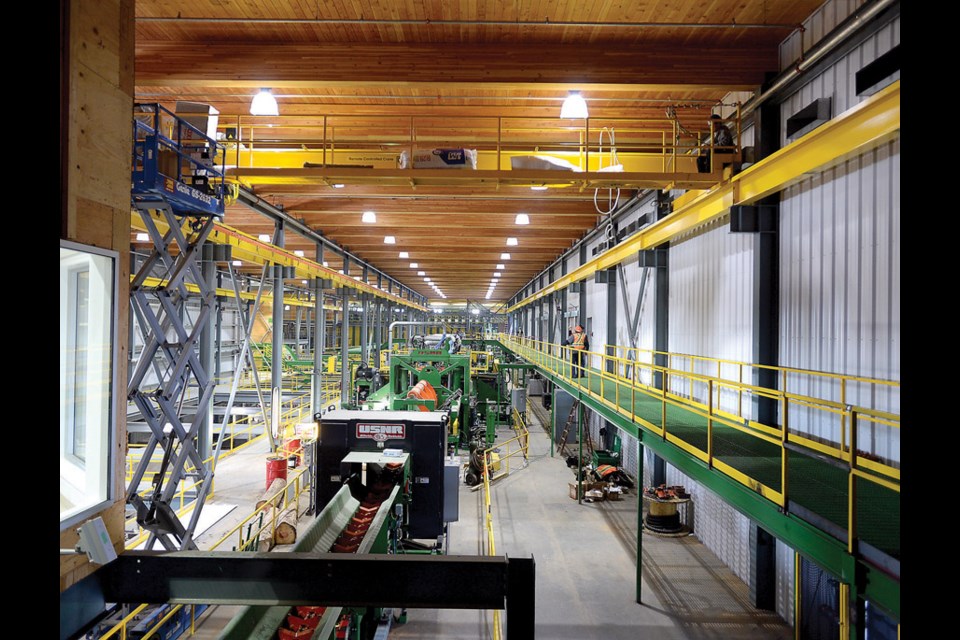The people behind Lakeland Mills are hoping to make the best of a bad situation when they start the sawmill next week.
"We're very excited about this project and getting it back up and running," said Sinclar Forest Products Group president Greg Stewart. "Obviously, the circumstances that have led to this are not ideal and it continues to weigh heavily on our minds, our thoughts and it's with that incident in mind that we put a lot of effort into this."
That incident was the April 23, 2012 explosion and fire that destroyed the sawmill, killed two employees - Glenn Roche, 46, and Alan Little, 43 - and injured nearly two dozen more.
During a Wednesday morning tour of the nearly finished reconstruction, mill management pointed out a variety of new safety and dust mitigation features that will be the new normal at Lakeland.
The whole mill was designed with dust mitigation in mind, said plant manager Marc Witte, who came on board in August.
For example, windows are mounted on the inside of walls to eliminate sills on which dust can collect, the walls are filled with mineral wool insulation so that little, if any, dust creeps in and stacks up and the operator control room's walls go right to the ceiling to help reduce any internal roofs.
As was made painfully aware to the entire industry following the Lakeland explosion and the one at Babine Forest Products in Burns Lake three months earlier, dust build-up can have tragic consequences.
A WorkSafeBC report on the 2012 incident concluded the explosion's ignition source was a gear reducer for a five-horsepower motor used to power a waste conveyor in the northeast corner of the mill's basement, directly below the log transfer deck for the slasher saws.
It's believed the gear-reducer's fan had come loose and became embedded in the steel screen covering that end of the assembly, grinding into it and coming to a stop. The shaft continued to spin at 1,750 revolutions per minute and the consequent friction raised the assembly's temperature to 577 C, well above the 410 to 430 C needed to ignite a cloud of wood dust. And since the fan was no longer turning, "the fine dust in the air could freely migrate into this immediate area, even within the shroud," the report says.
The new construction also includes peaked roofs where getting rid of the surfaces that could house dust builduup isn't possible, as well as beams rotated 45 degrees, dust-resistant cable trays and enclosed process centres where dust gets sucked away directly before escaping into the mill.
"There'll be some clean up - of course, it is a sawmill - but it's been reduced or eliminated wherever possible," said Witte. "The amount of dust collection is something like seven times what it was before. It's very, very significant."
Also new to the rebuilt facility is a system to remove methane gas.
The Lakeland site sits on what some believe to be a former landfill, but they didn't know about the methane, said Sinclar operations manager Bruce McLean.
"Somebody brought up the question, so we did some drill holes around, we started sampling and found it's present but it wasn't at explosive levels," he said. "By going all the way around and sampling it was determined it's throughout the site."
All of the buildings have wells drilled around them and the new mill site has piping underneath the concrete, said McLean. A negative pressure system draws the air from the ground and methane is piped out and discharged.
"At the end of the day, we recognize that the safety features are just equipment and that if we're going to be a safe mill, it's going to be the people themselves that are going to be making it safe," said Stewart. "We're all committed to making sure we have a safe operation once we start this thing up."
The mill will run with a total of 110 employees working on two shifts, 50 people less than the three shifts the mill ran before the explosion.
In a bid to develop better communication between employees and management, the building housing the old administrative offices will be torn down and management is moving inside the new mill building, adjacent to the employee lunchroom.
"If you want to be cold about it, it's truly efficient, but I just believe fundamentally that when everyone's working in the same place together, there's a lot more communication and better ability to be more responsive to what's going on in the mill," said Stewart.
As opposed to the 225 million board feet the mill was capable of producing in 2012, the new production capacity sits at an annual 200 million board feet. In addition to the American Lumber Standards dimensions of stud lumber Lakeland primarily manufactured, the new mill will also be able to spit out metric sizes. The planer mill is expected to be booted up in January once enough inventory has been built up from the sawmill.
An exact start-up date is difficult to pin down, said Stewart, but they're aiming for within the next week. About 80 employees are already on site.
"It's going to be starts and stops as we get to know the equipment and work through some of the challenges," he said. "We're going to be doing a lot of the start up and the commissioning of the whole system next week."
-- with files from Mark Nielsen



